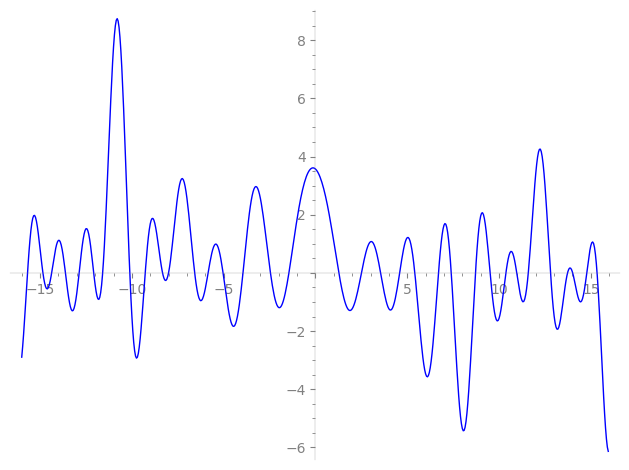| L(s) = 1 | + (1 + i)2-s + (1.22 − 1.22i)3-s + 2i·4-s + (3.72 − 3.33i)5-s + 2.44·6-s + (6.04 + 6.04i)7-s + (−2 + 2i)8-s − 2.99i·9-s + (7.06 + 0.388i)10-s + 6.03·11-s + (2.44 + 2.44i)12-s + (−0.224 + 0.224i)13-s + 12.0i·14-s + (0.475 − 8.64i)15-s − 4·16-s + (3.58 + 3.58i)17-s + ⋯ |
| L(s) = 1 | + (0.5 + 0.5i)2-s + (0.408 − 0.408i)3-s + 0.5i·4-s + (0.744 − 0.667i)5-s + 0.408·6-s + (0.863 + 0.863i)7-s + (−0.250 + 0.250i)8-s − 0.333i·9-s + (0.706 + 0.0388i)10-s + 0.548·11-s + (0.204 + 0.204i)12-s + (−0.0172 + 0.0172i)13-s + 0.863i·14-s + (0.0316 − 0.576i)15-s − 0.250·16-s + (0.210 + 0.210i)17-s + ⋯ |
\[\begin{aligned}\Lambda(s)=\mathstrut & 690 ^{s/2} \, \Gamma_{\C}(s) \, L(s)\cr =\mathstrut & (0.878 - 0.478i)\, \overline{\Lambda}(3-s) \end{aligned}\]
\[\begin{aligned}\Lambda(s)=\mathstrut & 690 ^{s/2} \, \Gamma_{\C}(s+1) \, L(s)\cr =\mathstrut & (0.878 - 0.478i)\, \overline{\Lambda}(1-s) \end{aligned}\]
Particular Values
| \(L(\frac{3}{2})\) |
\(\approx\) |
\(3.571623546\) |
| \(L(\frac12)\) |
\(\approx\) |
\(3.571623546\) |
| \(L(2)\) |
|
not available |
| \(L(1)\) |
|
not available |
\(L(s) = \displaystyle \prod_{p} F_p(p^{-s})^{-1} \)
| $p$ | $F_p(T)$ |
|---|
| bad | 2 | \( 1 + (-1 - i)T \) |
| 3 | \( 1 + (-1.22 + 1.22i)T \) |
| 5 | \( 1 + (-3.72 + 3.33i)T \) |
| 23 | \( 1 + (-3.39 + 3.39i)T \) |
| good | 7 | \( 1 + (-6.04 - 6.04i)T + 49iT^{2} \) |
| 11 | \( 1 - 6.03T + 121T^{2} \) |
| 13 | \( 1 + (0.224 - 0.224i)T - 169iT^{2} \) |
| 17 | \( 1 + (-3.58 - 3.58i)T + 289iT^{2} \) |
| 19 | \( 1 - 25.3iT - 361T^{2} \) |
| 29 | \( 1 + 37.7iT - 841T^{2} \) |
| 31 | \( 1 - 11.5T + 961T^{2} \) |
| 37 | \( 1 + (-20.7 - 20.7i)T + 1.36e3iT^{2} \) |
| 41 | \( 1 + 24.7T + 1.68e3T^{2} \) |
| 43 | \( 1 + (19.3 - 19.3i)T - 1.84e3iT^{2} \) |
| 47 | \( 1 + (-5.86 - 5.86i)T + 2.20e3iT^{2} \) |
| 53 | \( 1 + (-33.5 + 33.5i)T - 2.80e3iT^{2} \) |
| 59 | \( 1 + 20.0iT - 3.48e3T^{2} \) |
| 61 | \( 1 - 10.4T + 3.72e3T^{2} \) |
| 67 | \( 1 + (-22.9 - 22.9i)T + 4.48e3iT^{2} \) |
| 71 | \( 1 - 21.4T + 5.04e3T^{2} \) |
| 73 | \( 1 + (-25.3 + 25.3i)T - 5.32e3iT^{2} \) |
| 79 | \( 1 + 8.78iT - 6.24e3T^{2} \) |
| 83 | \( 1 + (47.9 - 47.9i)T - 6.88e3iT^{2} \) |
| 89 | \( 1 - 10.7iT - 7.92e3T^{2} \) |
| 97 | \( 1 + (63.2 + 63.2i)T + 9.40e3iT^{2} \) |
| show more | |
| show less | |
\(L(s) = \displaystyle\prod_p \ \prod_{j=1}^{2} (1 - \alpha_{j,p}\, p^{-s})^{-1}\)
Imaginary part of the first few zeros on the critical line
−10.11356373597633647349008273194, −9.272759638596197224521931107634, −8.329283327830296716453607958891, −8.002501990799053701802904191173, −6.57853223326943882513848737983, −5.84732681425291483726256145015, −5.03340174404686726681114912035, −3.94787159720647229741515287207, −2.45128428877403088407988274079, −1.44625357127227767855299720844,
1.27425427569080212562971073897, 2.50539939611960711235179908895, 3.54899818189974878984788396428, 4.58598489822476523607291684433, 5.41198911713270166566729819880, 6.70199836000308208006449273494, 7.39685683831333384458453453680, 8.716557614581808552177160137564, 9.514675955328734495041621982175, 10.37480056660419150685118331374

